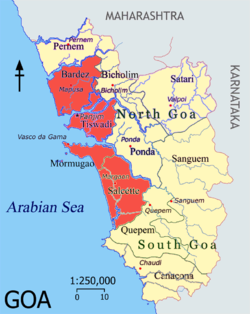Novas Conquistas
This article needs additional citations for verification. (November 2008) |
Novas Conquistas | |
|---|---|
Region | |
 Goa at its height under Portuguese occupation. The Novas Conquistas are highlighted in cream. | |
| Country | Portuguese Empire |
| Region | Estado da India |
| Historical Province | Goa Província do Norte |
| Concelhos | Goa: 7 Província do Norte: 8 |
| Parishes | 25 |
| Capital | Nova Goa (Pangim) |
The Novas Conquistas or "New Conquests" are a group of seven concelhos (municipalities) of Goa and Damaon, officially known as Portuguese India. They were added into Goa in the 18th century AD, comparatively date than the three original concelhos that make up the Velhas Conquistas, or "Old Conquests".
The seven concelhos of the Novas Conquistas are:
- Pernem,
- Bicholim,
- Sattari,
- Antruz (Ponda),
- Sanguem (modern-day Sanguem and Dharbandora),
- Quepem and
- Canacona.
Silvassa was a newly-acquired area in the Província do Norte.
In writing postal addresses, the Novas Conquistas were abbreviated "N.C."
History
[edit]In December 1764, Hyder Ali, the king of Mysore, sent his general, Fazalullah Khan, northward into Soonda via Bednur, where landowners who resisted his administration met severe retribution. Fearing capture, the Raja of Soonda fled to Goa and surrendered his territories below the Western Ghats to the Portuguese in exchange for sanctuary and a fixed annual stipend. The lower territories including the port of Sadashivgad, near Karwar, were absorbed into the Kingdom of Mysore.[1]
The new areas granted by the Raja of Soonda were incorporated into Portuguese Goa.
Later, in 1783, the Kingdom of Sawantwadi needed get Portuguese help against Kolhapur and so he ceded some parts of Pernem, Bicholim and Sattari to Portugal. The remaining part of Pernem (including Terekhol Fort) was ceded in 1788 and thus came to be known as the Novas Conquistas (New Conquests). Unlike the Velhas Conquistas, these areas remained predominantly Hindu, as the Portuguese lost their zeal of Christianization.[2]
Conflicts
[edit]Some lands in what would become the Novas Conquistas region had been acquired by the Portuguese prior to the 1783 treaty.
- Siege of Tiracol (1746)
- Siege of Alorna (1746)
See also
[edit]References
[edit]- ^ Sarasvati's Children: A History of the Mangalorean Christians, Alan Machado Prabhu, I.J.A. Publications, 1999, pp. 168
- ^ "The American Catholic quarterly review". archive.org. Philadelphia : Hardy and Mahony. p. 244. Retrieved 31 May 2017.
